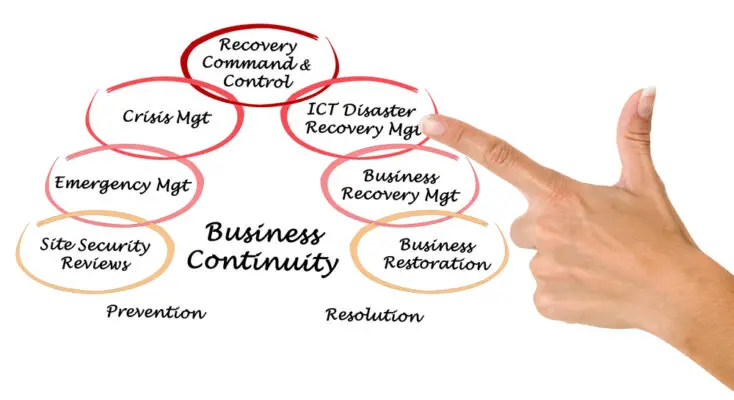Business continuity risk assessment is an element of any organization’s business continuity planning (BCP) strategy. This comprehensive approach aims to identify and evaluate potential risks that may disrupt normal business operations and hinder the organization’s ability to recover effectively.
Systematically analyzing risks, organizations can develop robust strategies and contingency plans to ensure continuity in the face of various threats.
This article explores the key components of risk assessment in BCP and highlights the benefits of conducting such assessments. It also delves into various risk assessment techniques that can be employed to identify and analyze potential risks.
Additionally, best practices for conducting risk assessments in BCP are discussed, providing organizations with a systematic framework to follow.
Adopting a thorough and analytical approach to risk assessment, organizations can better understand their vulnerabilities and develop proactive measures to mitigate potential threats.
This article provides valuable insights and guidance for organizations seeking to enhance their business continuity planning through comprehensive risk assessment.

Risk Assessment Components in BCP
The components of risk assessment in business continuity planning encompass various systematic and analytical approaches to identify, analyze, and evaluate potential risks and threats to an organization’s critical functions and processes.
A key component is the business impact analysis, which identifies critical functions and determines the potential impact of business disruptions. This analysis helps prioritize resources and recovery strategies.
Another component is the identification and assessment of potential threats, such as natural disasters, cyber-attacks, or supply chain disruptions. This involves thoroughly assessing the organization’s vulnerabilities and the likelihood of these threats occurring.
Risk management is another important component, which involves implementing controls and mitigation strategies to reduce the impact of identified risks.
The recovery time objective is also considered when assessing risks, as it helps determine the maximum acceptable downtime for critical functions.
A comprehensive risk assessment in business continuity planning ensures the organization is well-prepared to respond and recover from potential critical functions and process disruptions.
Benefits of Conducting Risk Assessment in BCP
Conducting a systematic evaluation of potential hazards and vulnerabilities can lead to a better understanding of the potential risks involved in business continuity planning. This process, known as risk assessment, is a critical component of developing a comprehensive business continuity plan.
Identifying and analyzing various risk scenarios, organizations can gain insight into the types of risks they may face and the potential impacts of these risks on their business continuity strategy.
Risk assessment involves a holistic approach, considering internal and external factors that could disrupt business functions.
Through a thorough risk analysis, organizations can determine the likelihood and severity of potential disruptions, enabling them to prioritize their efforts and allocate resources accordingly.
Conducting risk assessment in business continuity planning helps organizations proactively mitigate risks and develop strategies to respond to and recover from disruptions effectively.
Risk Assessment Techniques for Business Continuity Planning
This discussion will focus on various risk assessment techniques in business continuity planning.
One of the key techniques is Business Impact Analysis (BIA), which helps identify the potential impact of disruptions on critical business functions and processes.
Threat Analysis involves identifying and assessing potential threats to an organization’s operations and determining their likelihood and potential impact.
Risk Assessment Surveys and Risk Assessment Workshops are valuable techniques that involve gathering information from stakeholders to assess the likelihood and impact of risks.
Additionally, Risk Management Software can enhance the efficiency and effectiveness of risk assessment by providing a systematic and analytical approach to identifying, analyzing, and managing risks.
Business Impact Analysis (BIA)
Business Impact Analysis (BIA) is crucial in assessing the potential consequences of disruptions to business processes. It is integral to business continuity management, helping organizations identify and prioritize critical business functions.
BIA involves thoroughly and systematically evaluating potential risks and unforeseen events that could impact normal business operations.
By analyzing the potential impacts of disruptions on critical business functions, BIA enables organizations to prioritize their resources and focus on developing effective contingency planning.
This analysis helps organizations identify vulnerabilities, such as supply chain interruptions or disruptions, and develop strategies to mitigate these risks.
BIA provides a comprehensive understanding of the potential impacts of disruptions, enabling organizations to make informed decisions and develop robust business continuity strategies.
Threat Analysis
Threat analysis involves systematically evaluating potential risks and unforeseen events that could disrupt normal operations, enabling organizations to identify vulnerabilities and develop strategies for mitigation.
It is an essential component of a comprehensive business continuity plan, as it helps organizations anticipate and prepare for potential disasters or major disruptions.
Organizations can identify external threats impacting their ongoing efforts and operational capability by conducting a thorough threat analysis.
This analysis allows organizations to prioritize their resources and focus on protecting their mission-critical functions, ensuring business survival in the face of adversity.
Effective threat analysis provides valuable insights into the potential impact of various business continuity events, enabling organizations to develop contingency plans and implement measures to minimize the potential consequences of these threats.
Risk Assessment Surveys
Risk assessment surveys are valuable tools organizations can use to gather information and identify potential vulnerabilities and risks within their operations. These surveys help organizations assess the risk associated with various threats and identify areas that require mitigation.
Larger organizations often conduct risk assessment surveys to ensure their business continuity plans are effective and aligned with international standards. By systematically analyzing potential risks, organizations can determine an acceptable level of risk for each area of their operations.
These surveys also help identify potential human errors impacting mission-critical functions and vital records. Furthermore, risk assessment surveys enable organizations to evaluate the potential impact of a disaster on their operations and company reputation.
By adopting a comprehensive approach to risk assessment, organizations can proactively identify and address potential vulnerabilities and ensure effective business continuity planning.
Risk Assessment Workshops
Risk assessment workshops provide organizations with a collaborative platform to analyze potential vulnerabilities and identify strategies for mitigating and addressing these concerns. These workshops ensure business continuity by evaluating various dimensions of business continuity risks.
By bringing together key stakeholders, including employees, managers, and external experts, workshops facilitate a comprehensive understanding of the organization’s internal operations and external environment.
Through systematically evaluating risks, such as power outages or disruptive events, organizations can identify critical areas of concern and develop effective strategies to address them.
Workshops also enable the integration of risk assessment into the enterprise risk management framework, enhancing the organization’s competitive advantage.
Additionally, workshops contribute to developing a risk register and formulating contingency planning management, establishing a robust business continuity practice.
Overall, risk assessment workshops are essential for organizations to identify and manage potential risks proactively.
Risk Management Software
Risk management software provides organizations with a technologically advanced solution to streamline and automate identifying and addressing potential vulnerabilities, enhancing the effectiveness and efficiency of risk management practices.
This software plays a crucial role in business continuity risk assessment by enabling organizations to assess risks across the entire organization. It helps identify critical processes susceptible to disruptions and allows for developing effective disaster recovery plans.
Additionally, risk management software helps organizations to identify concentration risks and vulnerabilities in their supply chain, ensuring the security of supply and mitigating the potential impact of supply chain disasters.
Furthermore, it assists organizations in meeting regulatory requirements by providing a systematic approach to risk assessment and ensuring compliance with industry standards.
Overall, risk management software is an essential tool in developing a robust business continuity framework.

Best Practices for Conducting Risk Assessment in BCP
To effectively evaluate potential threats and vulnerabilities within a business continuity plan, employing industry-standard methodologies and frameworks is crucial when conducting risk assessments.
Risk assessment is a key component of the business continuity planning (BCP) process, as it helps identify and prioritize risks that could potentially disrupt business operations.
Best practices for conducting risk assessment in BCP involve a comprehensive approach that considers the contextually relevant factors for the organization. This includes:
– Understanding the business processes
– Identifying critical assets
– Determining the potential impacts of an unexpected event
– Assessing the likelihood of occurrence.
Following these best practices, organizations can develop a thorough and systematic understanding of their risks and effective strategies for mitigating them.
This ensures that business recovery activities align with the organization’s goals and objectives and that the BCP is integrated into the overall business process management.
Having a Contingency Planning & Management plan in a disaster is pretty important. So, let’s call it a disaster contingency plan. It’s like a safety net for when things go wrong. Just having one is not enough, though, we need to make sure it’s audited properly to ensure it’s effective.
Now, when it comes to designing something, we need to follow a process. It’s like a step-by-step guide to creating something amazing. We can even get a little radical and think outside the box. The key is to have a plan and stick to it.
It’s important to be prepared, especially regarding operational levels. We need to assess our level of preparedness and make improvements over time. It’s like a continuous cycle of getting better and better. And you know what? Even multinational companies need to do this.
Did you know that a whole field of study is dedicated to contingency planning and management? It’s pretty cool, right? And right now, there’s a current study happening in this field. It’s all about technology governance and how it affects different sectors. Interesting stuff!
Human resource development is another important aspect to consider. We need to take a human resource viewpoint and make sure that educational standards are met.
It’s like investing in our people and helping them grow. And you know what? It pays off in the long run.
Lastly, endpoint protection management keeps our systems safe and secure. We need to be prepared for emergent requirements and even plan for pandemics. It’s like being the superheroes of technology, saving the day and keeping everything running smoothly.
Frequently Asked Questions
Are there any legal or regulatory requirements for conducting risk assessments in business continuity planning?
Legal and regulatory requirements exist for conducting risk assessments in business continuity planning. Compliance with laws and regulations is essential to ensure the risk assessment process’s effectiveness, transparency, and accountability.
How often should a risk assessment be performed to ensure its effectiveness?
Risk assessments should be performed regularly to ensure their effectiveness. The frequency of these assessments may vary depending on factors such as the nature of the business, industry standards, and legal/regulatory requirements. However, conducting assessments annually or whenever significant changes occur is generally recommended.
What are the common challenges faced while conducting risk assessments in business continuity planning?
Common challenges faced in conducting risk assessments in business continuity planning include lack of resources, insufficient data, difficulty in prioritizing risks, resistance to change, and the complexity of interconnected systems.
Are any specific tools or software available to assist in conducting risk assessments for BCP?
Several tools and software are available to assist in conducting risk assessments for business continuity planning. These tools provide a systematic and analytical approach, allowing organizations to identify and evaluate potential risks to their operations.
How can the findings from a risk assessment be effectively communicated to key stakeholders in the organization?
The findings from a risk assessment can be effectively communicated to key stakeholders in the organization through clear and concise reports, presentations, and visual aids that highlight the identified risks, their potential impacts, and recommended mitigation strategies.

Conclusion
In conclusion, conducting a comprehensive risk assessment is crucial for effective business continuity planning. By identifying and analyzing potential risks, organizations can develop proactive strategies to mitigate these risks and ensure the continuity of their operations.
Various risk assessment techniques, such as SWOT analysis, scenario analysis, and vulnerability assessments, can be employed to gather relevant information and make informed decisions.
Adhering to best practices, such as involving key stakeholders and regularly reviewing and updating risk assessments, further enhances the effectiveness of business continuity planning efforts.
Overall, a systematic and analytical approach to risk assessment is essential for organizations to minimize disruptions and maintain resilience in the face of potential threats.

Chris Ekai is a Risk Management expert with over 10 years of experience in the field. He has a Master’s(MSc) degree in Risk Management from University of Portsmouth and is a CPA and Finance professional. He currently works as a Content Manager at Risk Publishing, writing about Enterprise Risk Management, Business Continuity Management and Project Management.

